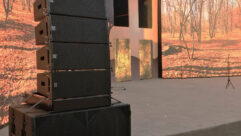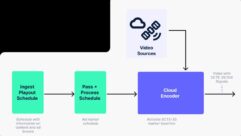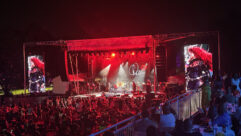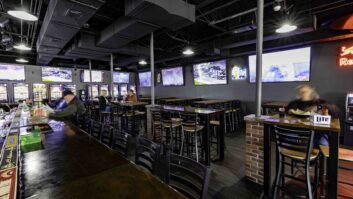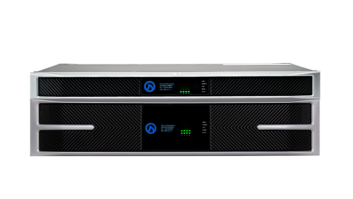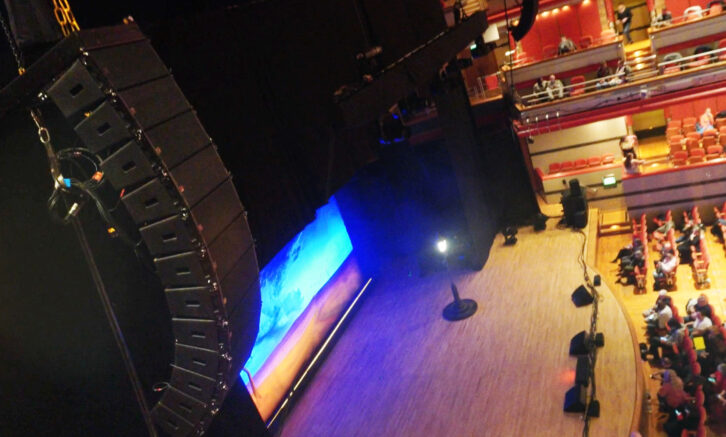
Take one artiste, one hyper-cardioid wireless mic and 35 years of comedy history and you have Eddie Izzard’s Remix Tour Live. Take an unimaginably disparate collection of venues and halls, ranging from 2,200-cap down to 840—some with tiered balconies, and some with no flying facilities—add in weird sound effects ranging from dinosaurs to Darth Vader (and a whisper to a scream) …and you potentially have a mighty headache for the production team.
Fortunately Eddie has toured with Martin Audio’s scalable, compact and supremely versatile WPS line array previously, and her production crew are well aware of the system’s adaptability. In fact Solotech senior account manager, Robin Conway, discloses that “the last Eddie Izzard tour [Wunderbar, in 2019] was part of the reasons I bought WPS in the first place. This time around production and I wanted to try and provide the same level of consistency while retaining a single truck.” Hence the inventory was stripped back to a bare minimum.
The sound design was expertly reworked from venue to venue by the experienced FOH team of sound engineer, Scott (Scoobie) Scherban and system tech, Rayne Ramsden—working alongside production manager, Stephen Reeve. They knew to expect the unexpected, and as Rayne put it, “each venue has been a beast of its own.”
Production carried just 24 WPS to enable 12-a-side elements to be flown at the largest venue, Birmingham Symphony Hall (2,200-cap), as well as four SX218, half a dozen DD6 (generally as lipfills) and a pair of XD12 for various balcony delays or sidefills. This scaled down to just a pair of WPS a side ground stacked on a single SX218 at bijou theatres such as the Brighton Theatre Royal and Richmond Theatre. The rig, in whatever configuration, is driven in the optimum 1-box resolution from Martin Audio’s iKON multi-channel amplifiers. Elsewhere, in Glasgow they had a stacked six-a-side WPS on a single SX218, while in Cardiff they reverted to a vertical SX218 with four WPS stacked on top, presenting the potential problem of obscured sightlines. To say WPS had to function as a workhorse is putting it mildly.
Scoobie was highly complimentary of WPS’ ability to achieve the near impossible, citing one venue which only permitted a single sub with four WPS stacked on top. “It did an incredible job,” he said. “To be able to ground stack like that and manage to cover three balconies up is pure genius.”
He faced the additional challenge of contending with a vast assortment of mic gymnastics (bordering on abuse) as Izzard worked through trademark classic skits. He approached it as a “hybrid rock / theatre show,” explaining … “the thunder and lightning effects make the opening surprisingly big and bold … and so it has to be loud.”
Vocal simulations range from his Darth Vader [Canteen of the Death Star] sketch where she’s cupping the mic, to capturing her imitating dinosaurs eating, notes Scoobie. “There is a lot of mumbling, and the challenge is to capture the sound from the most subtle level right the way through to absolute scream. The gain on the microphone is huge.” Two separate preamps were assigned to the mic—one dedicated to speech, the other for her effects channel to get the level up sufficiently.
Rayne Ramsden also highlighted the challenges of deploying different stacked PA configs in venues without hanging points or low weight bearing capacity.
Getting a single mic to travel with power and clarity into the deepest recesses of small venue was one of Rayne Ramsden’s prime concerns. ”Having the one-box resolution was really useful in being able to move the audio within the space”, he says. But he also needed to minimize the sound coming back off the box that the mic would inevitably pick up “and make sure it is as limited as possible.”
He has been using Martin Audio DISPLAY 2 software to optimize the sound. “It’s much quicker to get a 2D CAD slice out than to draw the whole venue particularly when you don’t have pre-given calculations.” He has also made full use of the Hard Avoid feature in DISPLAY. “There’s been a lot of usage of that onstage,” he admits, “to avoid the rear side of the box. Also, some of the venues had a tiered roof that I had to make sure I didn’t hit.”
Having worked with WPS now in many different modes and deployments, he concludes, “The great thing about WPS is that it’s a big sounding box in a small format, which helped keep the sightlines as clear as possible. You can use it anywhere … as a nice complement to WPL as delays or side hangs.” Or clearly as a stand-alone workhorse PA in its own right.
Supporting video (Watch Below) : https://www.youtube.com/watch?v=XZG58-9unnA
For more information: https://martin-audio.com
For more information: https://martin-audio.com


